Malevolent Anal Distraction
Malevolent Anal Distraction
The media’s reporting on the "Queering Nuclear Weapons" essay written by a new national nuclear security official obscures something much darker
John Carter
Nuclear security is, I’m sure you do not need to be convinced, a deeply serious matter. Ever since we cracked the atom over Hiroshima our civilization has been walking a tightrope over an abyss. A single misstep could mean annihilation – hundreds of millions dead within minutes, billions within days. Doubtless there would be some survivors, but it’s doubtful that industrial civilization would survive. We’ve come within a hair’s breadth of this a few times, not only in the Cuban Missile Crisis, but on other occasions, when radar mulfunctions or computer glitches left launch officers in the USA and the former USSR unsure whether or not to press the big red buttons they were entrusted with. Fortunately for everyone, they didn’t. If they had, none of us would be here.
Nuclear power plants can be almost equally dangerous. We saw the consequences of mismanagement in the 80s, with Chernobyl. Political officers who had no idea what they were doing covered up one screw-up after another. The results horrified a continent and poisoned the good name of the nuclear energy to this day.
Nuclear security, of civilian infrastructure and especially of the strategic weapons reserve, is the kind of thing that you want deeply serious men in charge of. The kinds of guys who wear impeccable grey suits, didn’t laugh because they don’t think your joke is funny, and have multiple degrees in military history and nuclear physics.
In keeping with clown world’s inversion imperative by which the last shall be first and the first shall be last, a couple of years ago we were treated to the spectacle of the Biden administration’s appointment of Sam Brinton, nuclear engineer and transvestite, to the position of Deputy Assistant Secretary for the Office of Nuclear Energy.
Brinton did not give off the air of a deeply serious man.
He only lasted six months, getting fired after stealing a woman’s luggage at an airport so he could wear her panties or something. Fortunately, Brinton’s replacement looks like a much more serious person.
Still, everyone wondered, what the hell was this circus freak doing in a senior position – just two steps below the head of the organization responsible for the Department of Energy’s nuclear program? Sure, he wasn’t in charge of nuclear weapons. Just spent fuel and waste disposal. Which is no big deal. It’s one of the most potentially deadly problems faced by the civilian nuclear industry.
And now, here we are again. The Department of Energy’s new Special Assistant for National Nuclear Security Administration, one Sneha Nair, is also the author of an article titled Queering nuclear weapons: How LGBTQ+ inclusion strengthens security and reshapes disarmament.
The National Nuclear Security Administration is a semi-autonomous alphabet agency responsible, as its name implies, for maintaining the security and efficacy of the USA’s nuclear weapons stockpile. Its remit also includes preventing the proliferation of WMDs, overseeing the provision of nuclear propulsion for the US Navy, and responding to radiological emergencies.
These are not small things to be responsible for, and one of their newly appointed senior administrators is apparently obsessed with painting rainbows on the warheads.
Let’s have a look at her.
Unlike Brinton, Nair doesn’t obviously look like a spiteful mutant. No aposematic hair colouring, no facial piercings, no obvious tattoos, nor any other obvious signs of mental illness. Her Xitter account doesn’t even proclaim her pronouns.
So unlike Brinton, there’s no obvious evidence that she’s a sexual deviant. By all appearances, she’s merely another overly earnest head girl, looking to burnish her virtue via demonstrative allyship.
Most of the media coverage was just lol’ing at the woke absurdity of the title of Nair’s article – what could adult diapers, dildos, bugchasing, and Monkeypox possibly have to do with preventing the fiery nuclear annihilation of the human species? Aside, that is, from keeping the observably mentally ill as far from the big red button as possible? What fresh madness is this? But we’re all inured to the regime’s infinite absurdity, these days, so after having a sensibly cynical chuckle we all moved on. I shrugged and moved on myself, until a few days ago when Stelios Panagiotou of Podcast of the Lotus Eaters took the time to actually read Nair’s work. What he found wasn’t lolcow fodder. It was deeply sinister.
The Queering nuclear weapons article was published a year ago in the Bulletin of the Atomic Scientists, one of those formerly sober publications, like Scientific American or Nature, which now publishes things with titles like “Queering nuclear weapons”. The article opens thus:
“They should not allow mentally ill people near weapons of mass destruction.” That was one of dozens of derogatory tweets that the Vienna Center for Disarmament and Non-Proliferation received in response to a December 2022 panel discussion on LGBTQ+ identity in the nuclear weapons space. Most of these tweets were purely hateful, written by trolls. But some respondents explained their opposition, saying that talk about queerness was inserting a non-issue and “derailing” discussions of nuclear weapons. All showed a keen determination to misunderstand the purpose of the event.
Serious people would simply nod and stop right there. Far from being ‘purely hateful’, there’s an incredibly tight correlation between homosexuality and a whole litany of mental illnesses, making it a comorbid indicator for the kind of unstable personality that you indeed do not want coming within a football’s throw of WMDs. But Nair needs to demonstrate that Queer Theory, rather than an academic pseudo-discipline of zero relevance to the fate of billions (or, well, anything else for that matter), is in fact of central importance.
Most of what follows is tediously predictable boilerplate about how diverse teams are better at identifying and solving problems due to their open exchange of information, all of which is based on a discredited McKinsey study that failed to replicate (yes, I’m as shocked as you are). We need to create welcoming environments in order to tap the alphabet people’s deep reservoir of high-quality human capital, enhanced above that of the boring and despised cishets by the special skills they develop due to their lived experience, such as trading STDs with hundreds of sexual partners the capacity to “navigate being different from those around them; develop the ability to listen and empathize; and mobilize the skill and perseverance to make themselves heard.” Exhibitionists are certainly very good at making themselves heard, as anyone who has wandered too close to a Pride parade can attest. Nair insists that the culture of nuclear security needs to be changed in order to free gay personnel to bring their whole, authentic gay potential to work. Of course, she’s also concerned with the hurt feelings of women:
Diversity and inclusion are especially important for the policy community dealing with arsenal development and nuclear posture. Women familiar with this “nuclear priesthood” describe it as “male-dominated and unwelcoming.” Homogenous groups like this are prone to groupthink and hostile to critical examination of baseline assumptions about how adversaries construct and identify nuclear threats and risks. For nuclear weapons policy, this has meant the perpetuation of theories like deterrence and crisis stability, which have contributed to increasing nuclear arsenals and a growing risk of nuclear use.
Men entrusted with developing nuclear strategy are exceptionally careful about who is allowed to join their ranks, the fiends. It’s not like the stakes are particularly high. Also notice that she doesn’t identify an alternative to nuclear deterrence ... which, say what you will about it, has proven effective for almost 80 years, now. The claim about increasing nuclear arsenals is an interesting one.
So far as I know the main country increasing the size of its nuclear arsenal is the People’s Republic of China. Who aren’t likely to start queering their warheads anytime soon. I’m sure Nair knows what she’s talking about, though.
Nair goes on to say that excluding people for sexual deviance is bad for national security, because reasons. Perhaps this is because if they can’t bring their authentic gay selves to work they’ll be out in the street being authentically gay, and the Russians will nuke us out of disgusted annoyance. She talks for a few paragraphs about how this is mean, how we don’t need to worry about closeted homosexuals being blackmailed anymore because no one really cares, which is true enough, more’s the pity. She then discusses how workplace sexual harassment can decrease organizational effectiveness by poisoning the professional environment, which is also true enough ... but it’s funny how it never seems to click for them that maybe there are good reasons that workplaces used to sexually segregated? It also seems to be incompatible with the argument that diversity inherently improves workplace culture. Surely, if people are prone to mock, bully, and ignore those who are different from the in-group, then adding large numbers of out-groups simply adds additional opportunities for occupationally deleterious social friction?
Most of the rest of the article is verbiage about how nuclear deterrence is rational and masculine (bad), unilateral disarmament is emotional and feminine (good), how gay people have advocated for disarmament in the past, and how we should spend more money on dem programs and less on defence.
Dem programs are starved of funding, you see. Completely squeezed out of the budget.
About halfway through the piece, however, we find the entrance to a very disturbing rabbit hole.
Including a wider range of perspectives in nuclear decision making creates a more comprehensive definition of who or what constitutes a “threat” to nuclear security. An example of this is the threat posed by some white supremacist groups with plans to acquire nuclear weapons or material, which can go undetected when a white-majority workforce does not perceive these groups and their ideological motivation as a relevant threat to their nuclear security mission. Individuals targeted by these kinds of groups—including women, people of color, and the LGBTQ+ community—are more likely to identify these types of behaviors and attitudes as security risks and can play a crucial role in identifying a potential insider threat.
In the entire article, the only time she really mentions anything at all to do with nuclear security per se is in the above paragraph, in which she suggests that we must use diversity to widen our perspectives of a ‘threat’ to include white supremacy. This makes me suspect that Nair doesn’t really care about ‘queering nuclear weapons’ at all – that the rainbow is nothing but dazzling camouflage, intended to conceal her actual aim. The media’s focus on the comedic nonsense of Queering nuclear weapons is missing the real story entirely.
The first link in that paragraph is to an early paper authored by Nair, this one titled Diversity, Equity, and Inclusion in Nuclear Security Culture: Insider Threat Assessments at Nuclear Facilities. Here’s the abstract (emphasis mine):
In the face of evolving threats, nuclear security frameworks must adapt to new risk factors and challenges, both internal and external. In examining what factors are the most likely to indicate an insider threat from nuclear facility personnel, the systems and methods to identify indicators – both for new hires and existing personnel are based off of problematic and antiquated conceptualizations of who or what constitutes a threat. For nuclear facilities to more effectively screen their personnel for insider threats, a more diverse, equitable, and inclusive (DE&I) security culture must be the norm. By creating a DE&I security culture, nuclear facilities can more effectively incorporate these elements into their broader nuclear security architecture from the ground up. This paper will examine cases studies of insider threat incidents through a DE&I lens to highlight where gaps in nuclear security insider threat assessments exist. It will then go on to argue that by implementing DE&I into personnel reliability programs and nuclear security culture, nuclear facilities can improve insider threat assessments to screen for domestic violent extremists, protect against foreign threats, and more effectively identify risks to nuclear facilities.
Nair is explicitly conceptualizing DEI as a means of inserting a political police force whose task is to scrutinize nuclear facility personnel to ensure that only regime loyalists who think regime-approved happy thoughts are allowed near to the facilities. The idea that the primary threats to American nuclear infrastructure come from foreign adversaries is antiquated and racist; the real threat is now internal, posed by ‘domestic violent extremists’. Indeed, she gives the game away in the paper’s second paragraph:
For decades, the U.S. has constructed the image of a ‘threat’ to fit a very particular image – specifically an image of someone who doesn’t present as an ‘American.’ This default American image is almost always presented as a white individual, with people who fail to present in this this [sic] way being subject to additional scrutiny. This ‘othering’ of non-white and otherwise ‘non-American’ presenting individuals reinforces problematic biases in national and nuclear security frameworks.
Just because someone looks foreign and speaks with an accent doesn’t mean that you should scrutinize them more carefully before letting them close to a nuclear reactor. It would be racist to operate on the assumption that Muhammed Al-Muhammed might be working for ISIS, or that Wang Wei could be an operative for the CCP. Conversely, just because James Jackson’s family has been in North Carolina since the 18th century and has fought in every war since the French and Indian is no reason to think he’s a loyal American.
In a sense, she isn’t wrong about this – this is an inherent complication introduced by mass immigration. A racially diverse population loses all external signifiers of belonging: neither appearance, nor language, nor faith can serve as a reliable in-group indicator. As the state peels away from the ethnic loyalties that once bound it together, it can no longer count on the default loyalty of its core population. The result is that everyone is under suspicion.
Of course, some will be under more suspicion than others:
While focus on foreign threats and radicalization must be maintained, the guidance and framework for assessing threats must remain flexible enough to adapt to an evolving threat environment. In examining cases of U.S. domestic terrorism in 2021, 49% of all domestic attacks were committed by white supremacists and affiliated far-right groups – as opposed to only 4% of attacks committed by Islamic extremists. This trend has even been acknowledged by top national security players, with U.S. Attorney General Merrick B. Garland and Homeland Security Secretary Alejandro N. Mayorkas identifying the greatest domestic threat facing the United States as “racially or ethnically motivated violent extremists,” specifically highlighting white supremacists.
That would be the same Mayorkas who threw the border wide open to tens of millions of migrants. I guess he must have decided that treating foreigners like potential security threats was outmoded, xenophobic racism.
As to the claim that far right white supremacists are responsible for a large plurality of domestic terrorism, I’m ... skeptical. There have certainly been examples of right wing terrorism, mostly mass shootings and shootings at protests. In most of these cases the shooter was clearly psychotic, and could as easily have been motivated by any other ideology. At the same time, authorities have been notably reluctant to release information relating to left-coded mass shootings, as in the Nashville trans shooter, whose manifesto the police sat on for months, before it was finally leaked ... and something tells me that even after authorities were finally forced to admit that Audrey Hale was motivated by her hatred of cishet White men, it wasn’t counted as terrorism. Then there are the fiery but mostly peaceful BLM riots: do the palettes of bricks that were mysteriously showing up on the streets before the rallies count as terrorism, or nah? You know the answer, which is the same answer as whether the BLM assault on the White House or CHAZ trying to carve an independent polity out of US territory counted as insurrections. The devil is in the definitional details, and if there’s one thing the enemy knows how to do, it’s how to twist the definitions of words to mean what they want them to mean.
Nair’s paper continues:
Maintaining disproportionate focus on foreign or externally influenced threats, when domestic actors pose a much larger concern in the domestic threat environment, has institutionalized biases and exclusionary behavior that can exacerbate the risks posed by insider threats. Approaching nuclear security culture and insider threat prevention programs with a DE&I lens can help identify some of the underlying structural biases in place and create solutions to address them in a way that reduces nuclear security vulnerabilities.
In other words, the primary threat to US nuclear security is not foreign adversaries, but ‘far right white supremacist domestic violent extremists’, and DEI officers are the heroes we need to stop them. This is only sensible: if there’s one thing you know about white supremacists, it’s that they’re white, and if there’s one thing you can rely on DEI officers for, it’s an unsympathetic disposition towards white people.
The remainder of Nair’s paper is devoted to two case studies, purporting to demonstrate the threat that white supremacists pose to the nuclear infrastructure. Her first case study is Brandon Russell, founder of Atomwaffen, and her second is Ashli Babbitt, the J6 martyr.
Atomwaffen, if you haven’t heard about them, were an extremely small underground neonazi group that even other neonazis thought were a nest of absolutely bugfuck crazy psychopaths. Their ideology, as far as I’ve ever been able to make it out, was essentially doing evil things for the sake of being evil. One of their members converted to Islam and then murdered his roommates, who were also in Atomwaffen; so far as I know the only people who have ever been killed by someone in Atomwaffen, are members of Atomwaffen. The group got infiltrated by the Order of Nine Angles, a literal Satanist cult who take the human sacrifice stuff very seriously. Atomwaffen is not a group that attracts your run-of-the-mill immigration patriot who wants to Make America Great Again, which is what people like Nair tend to mean by domestic extremism.
Brandon Russell fits into Nair’s narrative for a few reasons: he was, very briefly, a private in the Florida National Guard; he wanted to cause a nuclear apocalypse (hence the group’s name); he talked about attacking the local nuclear power plant; and when he was arrested with bomb-making materials, he was found to be in possession of the radioactive elements thorium and americium (which is used in smoke detectors). He was planning – or bragged that he was planning – on using the material to bomb a nuclear power plant. Nair quotes an Atomwaffen member to the effect that Russell knew how to build a nuclear bomb, and while Russell did have an undergraduate degree in physics, this is pretty far from proof that he did, in fact, know how to manufacture a nuke.
There’s no question that Russell is an aspiring terrorist ... which is to say that he is an unsuccessful terrorist, having been locked up once for trying to make bombs, then released, then promptly arrested and locked up again for planning to make more bombs, after telling the judge that he was going to make more bombs. As far as I can tell, DEI officers had nothing to do with his arrest: police officers noticed the bomb-making material in his garage after investigating the aforementioned murder by Atomwaffen’s Islamic convert, and started asking questions. There’s no particular reason to believe that having political police in the National Guard would have helped to detect his plans more quickly.
Nair introduces her second case study, Ashli Babbitt, thus:
An Air Force veteran who spent more than a decade in service, what she was perhaps better known for was her high-profile death during the January 6, 2021 insurrection at the Capitol Building in Washington, D.C. Once an avid supporter of Barack Obama, Babbit was radicalized on social media, subscribing to far-right mass delusions like QAnon and conspiracy theories including #SaveTheChildren, COVID-19, and the results of the 2020 U.S. Presidential election – which ultimately led to her violent death.
Notice the passive language about Babbitt’s (Nair misspells her name throughout) ‘high profile death’, which her participation in the unscheduled J6 walking tour of the Capitol insurrection ‘led to’. Babbitt died because she was shot in the neck by a Capitol Hill police officer. She was unarmed. Her behaviour could in no way be described as violent, nor could her petite frame have been interpreted in any way as threatening to the hulking black officer who shot her. The officer who murdered her was, of course, cleared of all wrongdoing.
Nair goes on:
While in the Air Force Babbit had a history of exhibiting insubordinate behavior – a trend that was chalked up to stubbornness and clashing with military hierarchy and her superiors – and kept her from rising through the ranks. Babbit also had two protective orders filed against her in 2016 and 2017. The first after allegedly ramming into her husband’s ex-wife with her car and the second after allegedly harassing the same woman by following her home and verbally assaulting her with calls and messages. What is troubling, is that despite all of these signs, and her avid social media support for debunked conspiracy theories as early as 2016, Babbit stayed on as an employee at the Calvert Cliffs Nuclear Power Plant from 2015 to 2017.
So she didn’t take orders well, and had a tendency to get feisty. I’d really love to know the details about her interactions with her husband’s ex ... I suspect there might be extenuating circumstances. It’s worth noting that Babbitt seems to have rammed her husband’s ex-girlfriend’s car with her car, not her husband’s ex-wife’s person. Which is crazy, but not the homicidal level of violence Nair implies. Beyond this the only thing that Nair can find to smear Babbitt with is that she believed in ‘conspiracy theories’ ... and that she worked at a nuclear plant. Did the temper and the conspiracy theories make her a problem employee?
A history of violence and insubordination is [a] clear red flag. While details on Babbit’s time at the Calvert Cliffs nuclear power plant have been limited, there is no evidence that she was placed on leave or had her clearance suspended or revoked after being accused of committing vehicular assault while being an employee at the facility.
It sounds like the Calvert Cliffs nuclear power plant had no reason to complain about her job performance. Once again, I’d love to know what Babbitt’s side of the story is regarding the vehicular assault; given that Babbitt’s husband was also employed at the facility, it seems quite plausible that her boss knew all about this, and was just like, ‘Yeah, your husband’s ex is a psycho bitch, just try to keep your cool, okay?’
The vehicular assault, however, is not Nair’s primary issue with Babbitt:
The Babbit case is furthermore an indication of the need for thorough social media analysis by personnel reliability programs. As an employee she was espousing conspiracy theories and mass delusions that undermined the foundation of American democracy and shared problematic falsehoods about individuals with different viewpoints than her own. These behaviors should have been cause for concern during routine screening, and yet, she stayed on at the facility for another year before leaving.
It isn’t sufficient to competently perform whatever function you have been hired to perform, comrade: you must also affirm the Our Values of Our Democracy, and you must never entertain any doubts as to the Official Narrative, even in the privacy of your own mind.
In juxtaposing Russell and Babbitt, Nair attempts to conflate two wildly different cases. Russell is a literal aspiring terrorist, once belonging to an actual fringe group of violent, meth-smoking, Satan-worshipping child pornography enthusiasts, who never actually got within a country mile of successfully implementing any of his demented schemes. Babbitt was a relatively well-adjusted married Air Force veteran; she was honourably discharged after service in both Afghanistan and Iraq; she had a tumultuous love life; she disagreed with the government about COVID-19 and the 2020 election; and her only violent interaction with the government was walking unarmed up to a government agent and getting shot in the neck.
One of them founded a tiny neonazi group – something like 40 members at its peak, or roughly 0.0001% of the American population – that literally just worships evil. The other possessed ‘extremist beliefs’ shared by tens of millions of other Americans. One of them was arrested with the makings of a dirty bomb. The other got in a fight with her husband’s ex.
Totally the same thing.
Now that she’s established an association between a rotten apple and ripe orange, Nair gets down to business.
Having outlined the nuclear security threat of far-right extremists, the next problem is determining how to fix the threat assessments. This is where the DE&I lens comes in. The most critical element of nuclear security that DE&I can address is in identifying threats. By using this approach, elements like race or ethnicity can no longer be used as sole disqualifiers when it comes to personnel risk assessment – thus creating space for domestic threats to be considered more thoroughly. This can refocus threat assessments on behaviors rather than falling back on the assumptions that come with racial and other types of biases.
Perhaps I’m naive, but I’m pretty sure that race has never been the sole consideration when assessing security threats. Other factors – mental stability, potential for blackmail, a history of drug abuse, prior felonies, sympathies for foreign adversaries – have always played a role, indeed, they have played the primary role. It’s not like security personnel have always been so naive as to discount the possibility of treason.
What Nair really means by this, of course, is that political officers can be used to root out ideological noncompliance.
Part of the problem facing nuclear security practitioners when it comes to developing nuclear security culture and insider threat identification programs is the homogeneity of the decision makers. The nuclear field has historically lacked diversity, whether it comes to racial representation, gender, sexual preference, or any other marginalization marker.
You see, security personnel were being chosen on the basis that they understood nuclear security, not on their adoration of Ibram X. Kendi, and this places us all in grave peril.
Creating pipelines to include marginalized perspectives in the decision-making process and considering equity opportunities for individuals currently in the field are important steps for diversifying the field.
DEI officers need to be placed in important positions regardless of whether or not they’re qualified.
The broader the perspectives included, the more expansive the definition of ‘threat’ for nuclear security. Different individuals with different lived experiences move through the world differently, and subsequently view risk and threat in a different light. Because the goal of nuclear security is to protect nuclear materials, weapons, facilities, technology, and knowledge from unauthorized use, the field benefits from a more expansive view and assessment of who or what could pose as an insider threat.
Men in dresses are likely to be quite troubled by your reluctance to keep track of where on the gender spectrum they are at any given time of day, and this is a risk to national security, because people who roll their eyes at performative pronouning are probably going to try and irradiate the city their family and friends call home by causing a reactor meltdown.
DE&I also strengthens nuclear security culture in facilities. Diversity tends to bring an openness to new ideas and places an emphasis on listening, which is central to creating an organizational culture in which personnel feel empowered to share instances of experiencing extremist behavior from peers.
If there’s one thing DEI enthusiasts are known for, it’s their openness to discussion. Sarcasm aside, what she’s saying is that we need to encourage employees to rat each other out for microaggressions.
If nuclear security facilities allow workers to be marginalized on the basis of race, sex, sexual orientation, disability, or any other factor, they create an [sic] workplace in which personnel are less likely to share concerns, or potentially even create an environment in which an employee could be blackmailed for insider information because of how they identify, the religion they practice, or any range of ‘othering’ factors. This is especially relevant in the context of far-right extremism, which often intentionally targets marginalized groups in their rhetoric and violent activities.
We need DEI officers to create a snitch culture that gets people fired for their personal beliefs in order to discourage blackmail, because that way, people’s personal beliefs definitely won’t be used to blackmail them.
A work environment in which personnel feel included is also likely to breed higher employee satisfaction, which in turn, improves performance and reduces the likelihood of insider threats going unnoticed. Equitable workplaces are also less likely to produce disgruntled employees who may be taken advantage of for insider access, due to external motivations like money or revenge.
Encouraging a snitch culture presided over by woke zampolit is practically guaranteed to produce disgruntled employees in large numbers. She seems to be suggesting that diverse workplaces are inherently a security risk, because of the probability of hurt feelings. She’s also almost making a threat: “give us DEI or the diversity we’ve already injected into your nuclear facilities will go stochastic and start blowing up nuclear power plants.”
Before being appointed to the DOE, Nair spent some years as a research analyst at the Stimson Center, which appears to be one of those large corporate-funded non-profit think tanks intended to incubate midwit academics so that they can give crazy nonsense a thin patina of intellectual respectability. Her biographical page at Stimson lists her publications. There are quite a few of them; she’s been a busy girl. The most significant of these appear to be two of the most recent, both much longer, much more polished policy papers covering the same themes as the work just discussed, but in much greater detail. The first is The Threat from Within: An Overview of the Domestic Violent Extremist Threat Facing U.S. Nuclear Security Practitioners. The second is titled Bias in Nuclear Security Implementation, which presents specific policy recommendations for countering the supposed insider threat. There are none of the typos, grammatical mistakes, and misspellings that littered her solo work, suggesting that she benefits from collaboration with others who can actually edit.
The funding for both of these works was provided by the U.S. National Nuclear Security Administration, which for some reason has an Office of International Nuclear Security’s Nuclear Security Women initiative. Nair’s coauthors look exactly like the SSREyed AWFLs you’d expect:
The Threat From Within attempts to establish the narrative that Domestic Violent Extremism, and in particular white supremacy, is the primary danger to nuclear security in the US. In the opening section of the paper, the girls make their case by stringing together the following elements:
A recent rash of successful and unsuccessful intrusions and attacks on power substations in Florida, the Northwest, Washington state, and North Carolina, some of which have been attributed to right-wing extremists, and one of which a right-wing Telegram channel speculated might have been performed by a neo-Nazi group. I’d be lying if I said that I hadn’t seen people discuss such sabotage as a cheap, easy means of sowing mayhem, but I’ve also seen radical environmentalists and deep ecologists talk about doing similar things.
A discussion of ‘accelerationism’, which the authors misunderstand as the idea that violent revolt is necessary to bring down the state; in fact, it refers to the idea that the best way to precipitate a violent revolt is to encourage the state to become as tyrannical as possible by provoking it, or even by enabling it, for instance by voting for the most tyrannical leftists on the ballot. The idea is to accelerate the state’s descent into intolerable oppression, thereby snapping people out of their complacency. It’s a very stupid idea, but one can see why the ladies might be motivated to miss the point on this.
A discussion of William Luther Pierce’s The Turner Diaries, an apocalyptic science fiction novel in which ethnonationalist terrorists bring down the US government using tactics that escalate through shocking levels of ruthless brutality, ultimately culminating in a nuclear Götterdämmerung. They suggest that Pierce’s book is used as a handbook by the far right, when really it’s treated more as Pierce’s over-the-top wish-fulfillment fan fic by almost everyone who reads it.
The J6 ‘insurrection’, which they argue shows that right-wing extremism has metastasized through the US population. Maybe they shouldn’t have stolen an election, I dunno.
The Oklahoma City bombing, which, fair enough, this was actual, unambiguously confirmed (and devastatingly effective) right wing terrorism ... although this notably leaves out the inciting role played by Ruby Ridge and Waco, without which it’s unlikely that McVeigh would have blown up the FBI’s Murrah Building. That isn’t to defend McVeigh, just to point out that the heavy-handed actions of the Federal government played the crucial inciting role.
Further extensive discussion of Atomwaffen, who once again seem to be the primary boogieman in their narrative, because while they never actually accomplished anything, they sure do look scary.
Studies indicating that active duty military and veterans are targeted for radicalization. The girls consider this particularly problematic from a nuclear security perspective as “All holding companies that own five or more nuclear power plants in the U.S. have veteran-specific hiring initiatives.”
The difficulty of detecting online extremism, due to it having been scattered across numerous platforms in the wake of the Great Shuttening, the adoption of coded rhetoric by those who remain active on the public platforms, and the fluid nature of the right-wing network, which makes identification of distinct groups somewhat pointless.
If you’re keeping track, their case so far rests upon: a few incidents of minor sabotage; a misunderstood concept from political theory; an old science-fiction novel; annoyed voters who took an unscheduled walking tour of their own building; an actual terrorist incident from almost three decades ago; a tiny group of antisocial weirdos who have killed no one but one another; their dislike of the politics of Army veterans; and their frustrated confusion with the slang used by Very Online shitposters. From this they weave a Clear and Present Danger.
This part was funny:
Reports show that qualified applicants with foreign ties or from certain racial or ethnic groups have been discouraged from applying to sensitive national security positions and faced barriers to obtaining a security clearance, in part due to preconceived biases held by investigators about certain racial or ethnic groups. This ‘othering’ of applicants at the first barrier of entry to participation in the nuclear security field also reflects a bias of preference towards candidates who fit a stereotypical ‘American’ image – suggesting that white applicants face less scrutiny during fitness investigations, as 55.2% of background investigators are white.
White people are about 65% of the overall U.S. population. Combined with the different shapes of the population pyramids of White and non-White populations, with Whites skewing significantly older, if anything this suggests that White people are already significantly underrepresented among background investigators. This one fact undermines their entire thesis.
Having tried to substantiate their narrative that the United States is under siege from its own population, the girls next attempt to illustrate these dynamics with four case studies: Brandon Russell, the Atomwaffen founder; Matthew Gebert; Sharif Mobley; and Ashli Babbitt. We’ll pass over Russell and Babbitt, as this paper simply reiterates what Nair wrote in the first paper we looked at (although at least Nair spells Babbitt’s name correctly this time).
Matthew Gebert was a State Department Official who came in during the Obama years (2013) and was fired in 2019 after getting doxxed by his own brother. He was radicalized all the way back in 2006 by an immigration bill co-sponsored by Ted Kennedy and the odious John McCain. He is not known to have engaged in violence. His dissident activities seem to have been confined to the following: podcasting with The Right Stuff under the name Coach Finstock; hosting meetups for other The Right Stuff fans at his house (where his wife baked swastika cookies); and attending Unite The Right in Charlottesville in 2017.
The only connection to nuclear security the girls can find is that Gebert once opined that White people needed an ethnostate with a nuclear deterrent. The authors seem to try to spin this as though he was planning to steal warheads to give to his podcasting buddies, when it seems more plausible that he meant a White ethnostate carved out of the current territory of the United States would need to inherit some fraction of the nuclear arsenal in order to be geopolitically viable ... which is just sensible realpolitik.
As Sharif Mobley’s name suggests, he is not White, but a second-generation Somali-descended “American” who became a radical Islamist during the Iraq war. Of the four individuals the girls examine, he is the only one who actually successfully engaged in systematic terrorist activities, after moving to Yemen in 2008 and joining Al Qaeda. He also had the longest stint working in a nuclear plant, from 2002 through 2008, where he managed to evade the usual scrutiny of background checks because he was a temporary worker, moving from plant to plant.
The Mobley case is an absolutely bizarre example to include. Mobley completely undermines the point that they are trying to make: he was a literal jihadi, a hyphenated Paperwork-American of obviously foreign appearance, following an alien religion, and therefore precisely the sort of external threat the authors are trying to downplay, while also being precisely the kind of marginalized minority they argue are subjected to too much scrutiny ... despite his apparently having been subjected to not nearly enough scrutiny.
This is hardly the only time that jihadis have danced around security checks. For instance, one of the security guards at the Manchester Arena bombing, Kyle Lawler, reported being deeply suspicious of the bomber, Salman Abedi, but let him go through because he didn’t want to be accused of racism. It would not be surprising if blind eyes had been turned to the numerous red flags Mobley was flying – such as calling his coworkers infidels and talking about jihad – because no one in the org chart wanted to be labelled an Islamophobe. Related to this, in their discussion of Babbitt the ladies trip over their shoelaces again, without appearing to notice:
Babbitt’s role as an employee at a nuclear power plant, in combination with her ideological beliefs, is troubling – especially when considering the appeal of nuclear infrastructure as a target for extremists. In 2015, a suspect linked to the Paris attacks was found with surveillance footage of a top official at a nuclear facility in Belgium. Authorities were concerned the Islamic State was potentially plotting to kidnap the official to obtain radioactive material for the terrorist attacks.
The last I checked, ISIS wasn’t an internal threat.
After weakening their case with their case studies, the authors look at actions already taken by the various branches of the Federal government under the Biden administration. They then discuss challenges to implementing DEI into the security architecture in order to suppress political opposition, which of course are principally Constitutional. The follow-up document, Bias in Nuclear Security, also includes the US Constitution under its ‘Challenges’ section. This choice is revealing. That the regime has long existed in a state of tension with the Constitution is obvious to everyone, but their impatience with the restrictions the First, Second, and Fourth Amendments place on their tyrannical impulses is increasingly leading them to drop the pretense of Constitutional loyalty. The New York Times just published a piece openly discussing eliminating the Constitution entirely, in order to replace it with something that gives them a free hand to reshape society without having their equitable hands tied by obsolete conceptions of liberty.
The ‘Challenges’ section concludes with the following:
As changes in social media and domestic politics evolve, it is worth considering if the assumptions about whether foreign or domestic threats are the most likely and the balance of protecting civil liberties is appropriate in the current national security environment.
Once we again, we see them pivoting to seeing the American people as the primary enemy.
Their discussion of Federal actions combating right-wing extremism is quite thorough, encompassing the Biden White House, the Department of Defense, the Department of Homeland Security, the Department of Energy, nuclear facilities, the Department of Justice, the Department of State and Congress. Much of it is either well-known, such as the national standdown of the armed forces following J6 to root out extremism in the ranks, or rather boringly bureaucratic, such as various reports that have been prepared bemoaning the threat posed by white supremacists, or mandatory training sessions to inoculate military personnel against radicalization, which sound like they must be so exceptionally boring as to verge on a form of psychological torment.
In their overview of Department of Defense actions, they implicitly admit that their own sloppy use of the word ‘extremist’, which they throw at everyone they don’t like, is getting in the way of their agenda:
The report found that DoDI 1325.06 does not have sufficiently detailed and easily understood definitions of extremism-related terminology, including the terms “extremist,” “extremism,” “active advocacy,” and “active participation.” Officials from the Office of the Under Secretary of Defense for Personnel and Readiness, the Office of the Under Secretary of Defense for Intelligence and Security, and the Military Services consistently stated that Service members and commanders do not know what behaviors constitute extremism or extremist activity. As a result, the DoD cannot fully implement policy and procedures to address extremist activity without clarifying the definitions of “extremism,” “extremist,” “active advocacy,” and “active participation.”
We see an example of this overly-broad definition in the DHS section:
However, despite the March 2022 report confirming that there was little DVE within DHS, on December 12, 2022 the Organized Crime and Corruption Reporting Project (OCCRP) and the Project on Government Oversight (POGO) asserted that more than 300 people identifying themselves as current or former employees of DHS or affiliated agencies appeared on an internal roster of Oath Keepers.
The Oath Keepers are apparently Domestic Violent Extremists, now. How many people have been killed by Oath Keepers? Zero? If you’re keeping track, white supremacist right-wing domestic violent extremism now includes: Atomwaffen; the Oathkeepers; QAnon; people who don’t like wearing masks; people who don’t like vaccines; people who vote for Trump; people who question the result of the 2020 election.
The real meat of the paper is in the Conclusion:
For decades, the U.S. has constructed the notion of a ‘threat’ to fit the visual of someone who doesn’t present as an ‘American.’ This carefully constructed ‘American’ image is almost always representative of the lived experiences of white people in the U.S., with people who fail to present in this this way being subject to additional scrutiny – irrespective of the status of citizenship, criminal background, or threat to the U.S. This ‘othering’ of non-white and otherwise ‘non-American’ presenting individuals reinforces problematic biases in national and nuclear security frameworks, creating an ‘us’ vs ‘them’ dynamic.
Putting threat and American in scare quotes is a pretty clear attempt at ‘problematizing’ these words ... a strange thing to do when American nuclear security is being discussed. Also note the critical theory phraseology: ‘lived experiences of White people’, ‘othering’, ‘reinforcing problematic biases’. These girls are theatre kids playing at nuclear security experts.
Given the historically homogenous nature of the nuclear security field dominated by white men in the United States, this has often placed women, people of color, and other historically marginalized groups under undue scrutiny by decision-makers in the field.
In other words, we need fewer white men, and the ‘marginalized’ people need to be the ones making the security decisions, so that marginalized people aren’t placed under undue scrutiny. Wait, weren’t they just talking of about Sharif Mobley? No questions! Moving on.
Crucially, the national security field has been pushed to re-examine how ‘threat’ and by extension, ‘security’ are defined by the dominant culture, in contrast to the perception of ‘threat’ and ‘security’ faced by people of color, which are “deep-rooted in American society and culture.” The discomfort that emerges from questioning traditional definitions of national security has received pushback, but new definitions are necessary, given “[the] way the U.S. defines threat does not adequately capture the challenges many people of color feel in America[,]” by largely failing to account for the security threats posed by individuals, governments, or crime.
Wait I thought we were discussing threats to nuclear facilities? Are we talking about threats to the self-esteem of minorities, now?
Nuclear security culture in the U.S. and around the world is intimately tied to the counterterrorism efforts that were put into place following the September 11, 2001, attacks. Nuclear security priorities reflect national security concerns, thus the conceptualization of ‘threat’ continues to place a disproportionate focus on foreign actors and movements, reproducing the ‘us’ vs ‘them’ distinction in security practices, even as threats facing national security evolve.
Security practices are quite literally an implementation of ‘us vs. them’. They make no sense at all outside of that dynamic. Us: the people security protects. Them: the people security protects from. This is just painfully stupid ... or dishonest, because they are implying that they are above ‘us’ vs ‘them’ distinctions, when they very obvious are not. They simply want to redefine ‘us’ and ‘them’.
Maintaining disproportionate focus on foreign or externally influenced threats, when domestic actors presently pose a much larger concern in the domestic threat environment, demonstrates the institutionalized biases and exclusionary behaviors that can exacerbate the risks posed by insider threats. Understanding the limitations of the national and nuclear security as being designed to provide security for only some – mostly white-passing Americans – at the expense of people of color and those with foreign ties, can allow for a more nuanced understanding of the vulnerabilities facing the nuclear security field today.
This is wild. Not only are white Americans now the primary security threat, but somehow nuclear security is only protecting white people? Do black people have some kind of a immunity to radiological damage?
We finally move on to Nair’s most recent, and most professionally produced, policy paper, Bias in Nuclear Security Implementation. Its basic argument is that personal bias can affect security, and that this is best mitigated by DEI. Rather than a think piece, it presents itself as a sociological investigation, using interviews from workshop participants as well as survey responses which, they amusingly note, they do not present statistically, given the very low level of response they received ... a whole seven people got back to them. I wonder why.
This paper starts with a reiteration of the narrative developed in the preceding policy paper, The Threat Within. This done, they move on to describing the policy changes they’d like to see. They want to invert who is worthy of protection, and who needs protecting from:
Historically, the domestic construct of a ‘threat’ was antithetical to the idea of an ‘American.’ This construct of ‘American’ has typically been biased toward the white, male, heteronormative population. Individuals who do not fit this image are often subject to additional scrutiny under the national security apparatus — irrespective of the status of citizenship, criminal background, or threat to the United States. This ‘othering’ of non-white and otherwise ‘non-American’ presenting individuals may reinforce problematic biases in national and nuclear security frameworks, creating an ‘us’ vs ‘them’ dynamic.
Structural bias is reflected not only in the design of the national security clearance process, which often examines those with foreign ties or from underrepresented groups more closely, but also in insider threat programs which monitor personnel behavior in certain categories and rely on inherently subjective co-worker and supervisor assessments of that behavior.
Foreigners are friends, domestics are enemies. Also, you shouldn’t pay too much attention to emotional stability or drug use, because, well, you know why:
As laid out in more detail in Section 4, monitoring of changes in finances, substance abuse, and mental health may disproportionately affect certain underrepresented demographic groups.
There’s a long whiny litany cataloguing the underrepresentation of various groups in various fields and organizations, the only possible explanations for which are isms and phobias. There’s some comedy gold buried in these sections:
For those who do enter the field, structural bias may manifest in a variety of ways that can make underrepresented groups feel unseen or excluded, contribute to high attrition/low retention rates over time, and hinder career advancement. For example, one workshop participant shared a story about her challenges carrying heavy equipment for a nuclear safeguards verification role, and how men often carried her tools for her. Another participant separately reaffirmed this point, stating that some of the monitoring equipment weighs about 40 pounds and is worn on the body.
Women have trouble lifting heavy objects. Stupid sexist gravity. Also, when you offer to carry something for women struggling under the load, this reminds them that they aren’t as useful as you, and makes them resent you. Remember this the next time you’re tempted to help.
some interviewees pointed to criminal records, drug offenses, and mental health interventions that are considered as part of U.S. security clearance investigations and may serve in that context to exclude segments of the population subject to racialized law enforcement practices and higher sentencing and incarceration rates.
Traditional red flags on background checks shouldn’t be used, or should be used much more lightly on black people. That sounds like it would be absolutely disastrous if implemented.
Those who get approved for the highest-level clearances appropriate for nuclear security work will naturally tend to be “really easy-to-clear, white, middleclass people. And not people who had to struggle,” said another of this study’s interviewees.
Boring middle class white people with clean criminal records, good educations, military service, and so on really are the worst. Definitely not the kind of people you want anywhere near nuclear facilities. It would be much more inclusive if vibrant crackheads from Baltimore whose mix tapes may or may not be multiple homicide confessions, illegal immigrants from Guatemala whose facial tattoos may or may not indicate ties to MS-13, and sullen Yemenis who may or may not work for ISIS, were guarding America’s nuclear power plants.
Women and minorities are not the only demographics that face undue scrutiny in the nuclear security field. Study participants noted a variety of biases at play in the field, including those related to age, military veteran status, contractor or federal employee status, and type and level of academic credentials. In particular, bias against those without a technical or scientific background, or who do not have advanced educational credentials, often overlaps with an individual’s gender identity, heritage, and socio-economic upbringing, resulting in white men staffing the technical and research-focused roles. One interviewee described how they felt the need to obtain a PhD in order to have their thoughts and opinions respected by technical staff, as highly trained technical staff often disregarded inputs, especially DEI-related inputs, from non-technical staff
The technical priesthood who run and maintain nuclear power plants place high value on mastery of the exact sciences for an extremely good reason: they are extraordinarily difficult to learn, that expertise is consequently rare and precious, and it is absolutely, non-negotiably essential to the safe and efficient operation of the stupendously complicated and potentially extraordinarily hazardous machines we call nuclear reactors. What this sounds like is that the engineers roll their eyes at the inane suggestions spilling out of the mouths of the whiny diversity girls – stuff like ‘maybe we should hire more black felons with multiple convictions as security guards’, for example – and that this hurts the feelings of the diversity girls, who go home feeling unvalidated and unappreciated. Which is a valid feeling for them to have, because they are not, in general, appreciated.
Having spent several pages complaining that there aren’t enough black women working at nuclear power plants, and that the ones who do work there don’t get listened to by the uppity nuclear engineers who run them, the girls explain why nuclear security absolutely requires more diversity in Section 5, Bias Mitigation to Strengthen Nuclear Security and Address DEI Challenges:
When structural bias enforces a norm and reduces the amount of diversity within an organization, not only does the organization lose a diversity of valuable input, but the political atmosphere can adopt characteristics of an “echo chamber.” Echo chambers are environments where individuals encounter beliefs and opinions that are similar to their own and are not confronted with alternative perspectives, often resulting in the amplification and radicalization of such beliefs. Echo chambers within the nuclear security field become more likely the less diversity of thought and background is present, which could result in the adoption of extremist political beliefs in some environments. The potential for such radicalization to occur within the nuclear security field creates a security issue for all nuclear facilities, stakeholders, and organizations, as it could result in compromised security measures.
This is nuts. They’re basically saying that because nuclear engineers are mostly white males, they might all read the Turner Diaries, conclude that nuclear armageddon is the only hope for the White race, and start giving Atomwaffen all the spent fuel rods they desire. Up until now they were implying that DEI could help prevent individual bad actors from infiltrating. Now they need DEI to prevent nuclear physicists from becoming terrorists.
The paper finishes with a large number of, mostly repetitive, recommendations for a comprehensive set of institutions and positions implicated in the nuclear industry: State and Federal government; Congress; the DOD; the DOE; intelligence and security agencies; the Nuclear Regulatory Commission; the US Government Accountability Office; the private nuclear industry; upper management; middle management; personnel; civil society groups; academia; and the media.
Their recommendations largely entail making public gestures of support towards DEI, collecting and reporting DEI-related demographic data, holding regular DEI training sessions, promoting consistent definitions of ‘extremism’, and of course, hiring more DEI officers and putting more money into DEI ‘research’. These are all very boring and bureaucratic, the sort of thing HR ladies would come up with during an all-hands Zoom meeting, but the overarching goal is to integrate DEI so thoroughly into nuclear security culture that it takes it over completely.
The overall image that emerges from all of this is incredibly sinister. Nair and her sisters paint a dire picture of an America – or, more accurately, an American federal government – under siege from radicalized factions of its own populace. They do this by using ‘right-wing extremism’ in an extremely broad sense without ever really defining it, lumping together everything from the Atomwaffen to the Oathkeepers to the Health Freedom movement to ordinary Trump voters, all of whom are cast in the role of violent lunatics who have been driven over the edge of sophisticated Internet propaganda.
The one thing all of these groups have in common is that they are overwhelmingly White. Thus, the traditional image of an American – a White person who speaks unaccented English – no longer defaults to ‘safe’, but becomes immediately suspicious. Because White people cannot be relied upon to police other White people, a new political zampolit of DEI officers, principally composed of non-Whites, must be imposed at every level in order to continuously scrutinize White employees for red flags that might indicate they are being radicalized by online information terrorists ... with, again, radicalization essentially meaning that they disagree with the Federal government (or more accurately the Democratic party) on literally anything. Those suspected of having been radicalized must then be disemployed.
Furthermore, since focusing on traditional security indices – criminal records, military service, mental health, technical competence – tend to result in a disproportionate fraction of White males being placed into responsible positions, these factors must be revisited. Meaning, in essence, that they must be abandoned, at least for the Diverse, in order for the diversity hiring and promotion pipelines to efficiently insert the Diverse into their roles as political officers ... and, presumably, security personnel, nuclear engineers, and technicians.
There is nothing really new about any of this. Our universities, corporations, and huge sectors of the government bureaucracy have been plagued by affirmative action for generations, and the deep rot of wokeness that has set in over the last decade has already degraded the operational capacity of our institutions to a shocking degree. Our police forces and militaries have bled out, with a mass wave of resignations from those disgusted with the perverse lawlessness of the woke regime, and recruiting crises driven by reluctance of the populace to support it. However, until very recently we at least maintained the residual good sense to try and prevent the decay from reaching those sectors of our infrastructure in which accidents can become catastrophes.
We know what happens when clueless political officers are given control over nuclear reactors. That’s how the Communist Party gave the world Chernobyl. One shudders to think what horrors could arise should bubbly theatre kids like Sneha Nair begin systematically replacing personnel at every level within America’s infrastructure with the least competent people the country can find.
I hate ending on a down note, but I don’t have any idea what you can do about any of this, unless you happen to work inside the nuclear industry, in which case I implore you to fight against it in every way you can, with every fibre of your being.
Source: Postcards From Barsoom

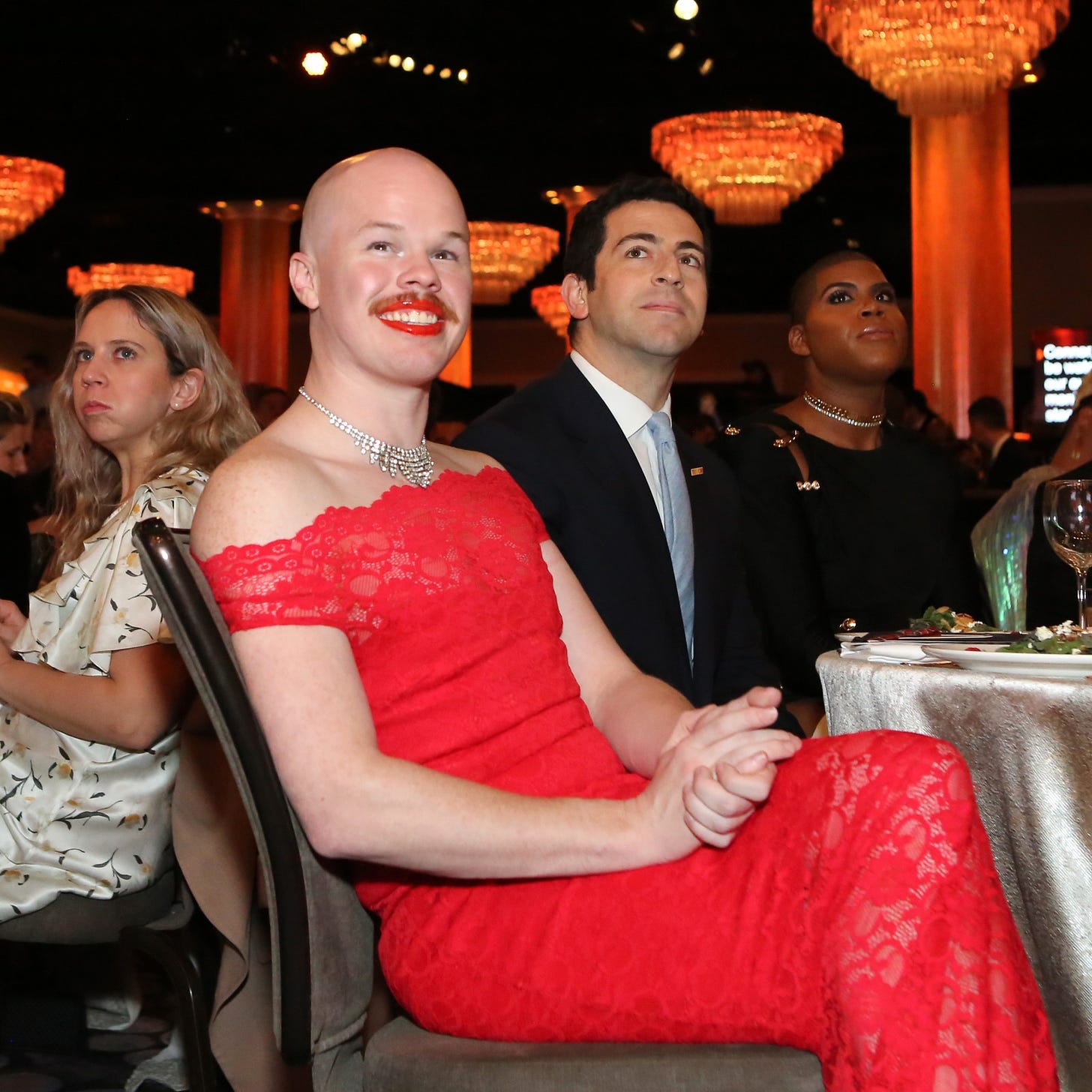


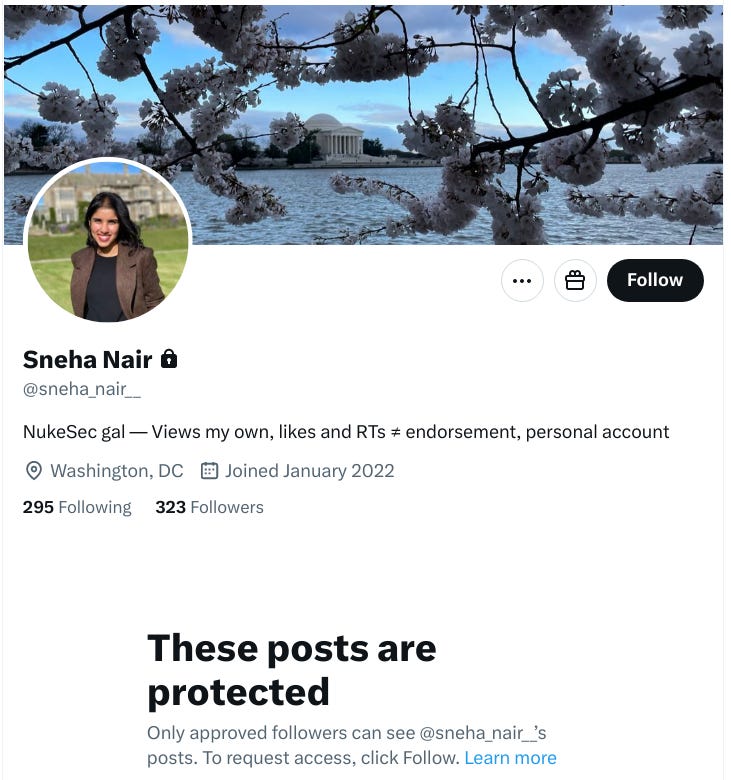
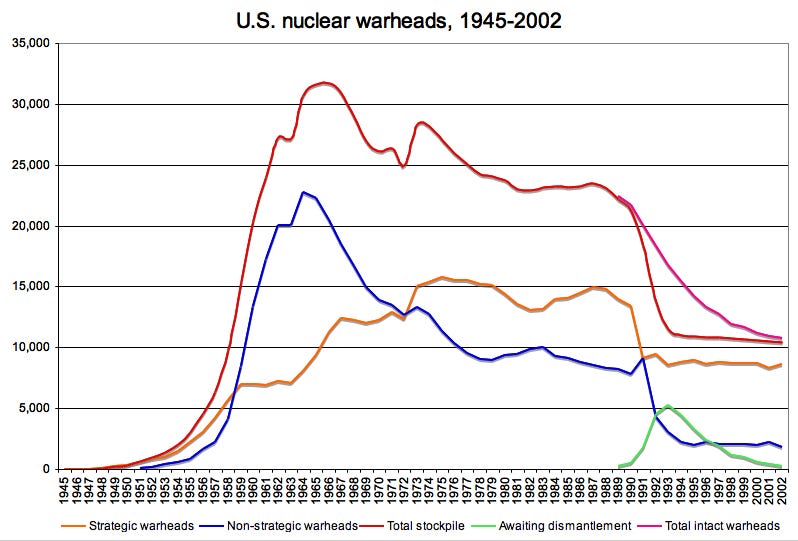
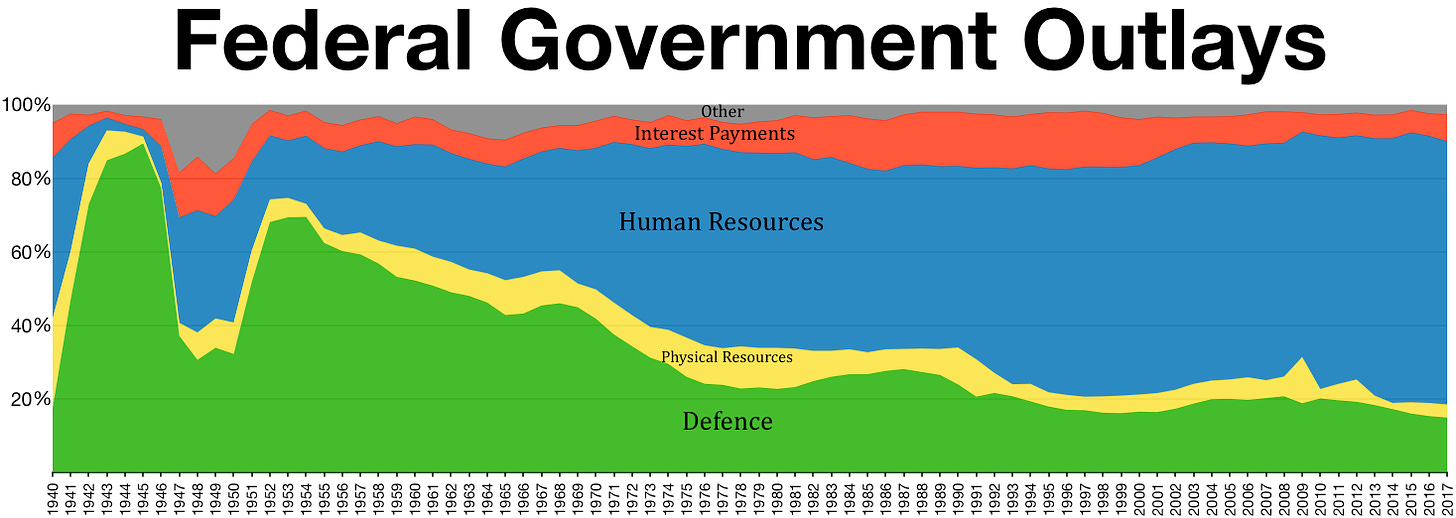





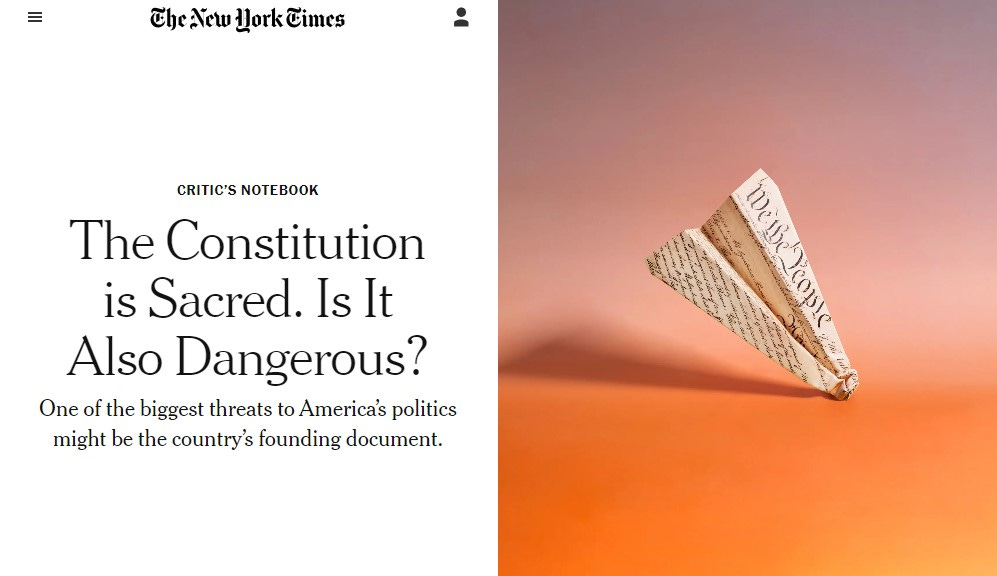

Comments
Post a Comment